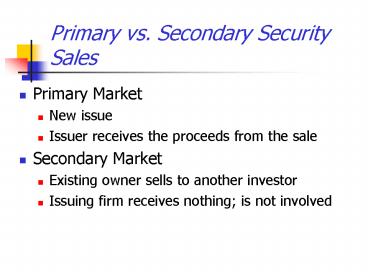Primary vs' Secondary Security Sales - PowerPoint PPT Presentation
1 / 10
Title:
Primary vs' Secondary Security Sales
Description:
Primary vs. Secondary Security Sales. Primary Market. New issue. Issuer receives the proceeds from the sale ... distribution syndicates (diversification) ... – PowerPoint PPT presentation
Number of Views:452
Avg rating:3.0/5.0
Title: Primary vs' Secondary Security Sales
1
Primary vs. Secondary Security Sales
- Primary Market
- New issue
- Issuer receives the proceeds from the sale
- Secondary Market
- Existing owner sells to another investor
- Issuing firm receives nothing is not involved
2
Investment Banking and Underwriting
- Investment bankerspecialist in issuing
securities - adviceconcerning market conditions
- underwritingtake risk of issuing securities
- distributionsyndicates (diversification)
- Prospectusdocuments the new issue indicates the
terms of the issue, use of funds, and so forth
3
Investment Banking Arrangements
- Types of Arrangements
- Negotiated purchaseissuing firm negotiates terms
with investment banker - Competitive bid purchaseinvestment bankers bid
on the issue - Best Effortsinvestment banker sells on a
contingency basis gives a best effort to sell
the issue, but there is no firm commitment that
the entire amount will be sold
4
Public Versus Private Placements
- Public placements (offerings)must register with
the SEC sold to the public - Initial Public Offerings (IPOs)first time a
sells stock to the investing public - IPOs generally are underpriced
- Investment bankers generally are involved in the
market after the initial offering of the stock - Private placementssell to a limited number of
sophisticated investors not registered - Institutional investors
- Market is more active for debt than equity
5
Stock (Bond) Markets
- Organized exchangesphysical locations
- NYSE
- AMEX
- OTC marketelectronic network
- NASDAQ
- Third markettrading exchange-listed stocks on
the OTC - Institutional investors with large blocks
- Fourth marketdirect trades of exchange-listed
stocks - Institutional investors with large blocks
- Electronic Communications Networks (ECNs)
6
Types of Orders
- Orders represent instructions to brokers (agents)
as to how to execute transactions - Market ordertransact at the best possible price
when the order reaches the market - Limit orderexecute the order only if a specified
price, or a better price, exists - Stop loss orderinitiate a market order when a
specifies price is reached - Time orderestablish time limits
- day orderthe order dies (expires) at the end
of the day - good 'til canceled (GTC)the order stays alive
until canceled
7
Stock Market ParticipantsExchange Seats
- Commission Brokerworks for a company with a seat
on the exchange - Floor Brokerindependent, freelance broker
farms out to others - Registered (floor) Tradertrades only for his or
her own private account - Specialistmarket maker specializes in certain
types of stocks (industries)
8
Margin Trading
- Borrow to purchase financial assets
- Important computations
9
Margin Trading
- Example An investor wishes to buy 100 shares of
IBM, which currently is trading at 100. The
brokerage firm imposes a margin requirement equal
to 60, with a maintenance margin of 35.
- The market value of the purchase is 10,000
100 100 - The investor must have 6,000 10,000 0.60 of
funds to purchase 100 shares of IBM - 4,000 10,000 - 6,000 10,000 0.40 is the
amount borrowed from the brokerage firm.
10
Margin Trading
- A margin call will be issued if the price of IBM
drops below 61.54































